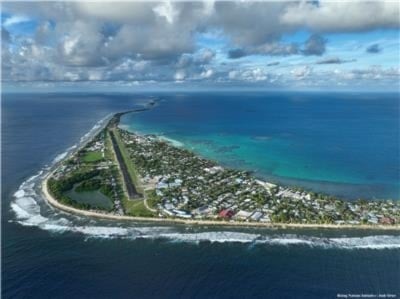Tuvalu begins historic climate migration as sea levels threaten future
Tuvalu launches first planned national migration due to sea level rise, with 280 citizens moving to Australia yearly under a new climate visa treaty.
-

Tuvalu (Rising Nations Initiative via AP)
Tuvalu is poised to become the first nation to undergo a planned climate-induced migration, as rising sea levels threaten to render much of the country uninhabitable within the next 25 years. The low-lying island nation is comprised of nine coral atolls and islands in the Pacific Ocean, and it is home to some 11,000 people with an average altitude of two meters above sea level, making it acutely vulnerable to climate change and extreme weather events.
A 2023 study by NASA’s Sea Level Change Team revealed that sea levels in Tuvalu have already risen by 15 centimeters compared to the three-decade average. If current trends persist, projections suggest that most of Tuvalu’s land and infrastructure will be submerged or unusable by 2050 due to flooding and saltwater intrusion.
In response to the existential threat posed by rising seas, Tuvalu signed the Falepili Union Treaty with Australia in 2023. The agreement marks the beginning of an unprecedented climate visa program that offers Tuvaluans a path to permanent residency in Australia. Under the treaty, 280 Tuvaluans per year will be eligible to migrate, gaining access to the same health, education, housing, and employment rights as Australian citizens, while retaining the right to return to Tuvalu if conditions allow.
Applications for the first round opened on June 16 and closed on July 18. On July 23, the Australian High Commission in Tuvalu reported “extremely high levels of interest,” with 8,750 registrations, including family members. The first cohort of 280 people will be selected through a ballot system on July 25.
Preservation of Tuvaluan identity through 'digital nation'
Climate law expert Jane McAdam of the Kaldor Centre for International Refugee Law at UNSW Sydney noted that with other migration pathways to Australia and New Zealand included, close to 4% of Tuvalu’s population could relocate each year. “Within a decade, nearly 40 percent of the population could have moved,” she stated, while acknowledging that return migration may occur.
Australia’s Foreign Minister Penny Wong emphasized that the migration scheme allows Tuvaluans to resettle “with dignity as climate impacts worsen,” and framed the initiative as a testament to “deep trust” between the two countries. She added that Tuvaluans will contribute meaningfully to Australian society.
Alongside its migration treaty, Tuvalu has launched an ambitious plan to ensure national continuity in the digital age. In 2022, the country initiated a strategy to become the world’s first “digital nation,” involving 3D mapping of its islands and the transfer of key government functions to virtual platforms. This digital preservation effort is accompanied by proposed constitutional reforms that would define Tuvalu as a virtual state, a concept already recognized by 25 nations, including Australia and New Zealand.
Tuvalu’s Prime Minister Feleti Teo, speaking at the UN Ocean Conference in Nice in June, called for the establishment of an international treaty to protect the rights of countries facing sea level rise. “Tuvalu calls for the development of an international treaty on sea level rise to enshrine the legal rights of affected states,” he said, and voiced support for a Fossil Fuel Non-Proliferation Treaty.
Tuvalu’s fate signals a global climate crisis
NASA’s satellite data shows that the global rate of sea level rise has doubled since 1993, with oceans rising by 10 centimeters in that period. Pacific island states are among the most exposed, but other areas, such as the Gulf of Mexico, are also experiencing dramatic increases, with recent studies finding sea levels there have risen at three times the global average.
Albert van Dijk of the Australian National University underscored the wider water-related impacts of climate change, warning that “from historic droughts to catastrophic floods, these extreme variations disrupt lives, economies, and entire ecosystems.” He stressed that water’s changing behavior now represents “one of the greatest threats” facing the planet.

 4 Min Read
4 Min Read











